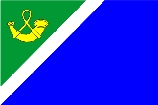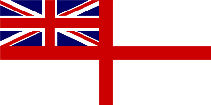- WAFT (or WEFT)
- A term, how obsolete, for a flag tied in a knot and displayed at sea as a
signal of some emergency (see also
flag of distress).
- WAR BANNER
- In UK usage a term, last used in 1853 and now obsolete, for a small white
triangular flag seen on military drums at a proclamation of war (see also
bannerette).
- WAR ENSIGN
- See naval ensign listed under ensign.
- WAR FLAG
- 1) An alternative term for the naval ensign.
- 2) A term - and a direct translation of the German Kriegsflagge or Spanish bandera de Guerra
- for that flag (different from the national flag) flown by a countrys armed
services, which is usually (but not invariably) the same design as the naval ensign
and/or state flag (see also battle flag 3),
state flag, and
naval ensign/war ensign under ensign).

![[Bolivia War flag]](../images/v/vxt-d347.gif)
War Flag of Peru (fotw); War Flag/Naval Ensign of Bolivia (fotw)
- WAR (or WARSHIP) PENNANT
- See masthead pennant 1).
Please note that war pennant is a translation of the French term "flamme de guerre".
- WATTLE(D)
- 1) On flags, a plaque, frame or ornament consisting of two or more interlaced
branches, and typically used on Croatian flags (see also
cartouche and
ring).
- 2) In heraldry, the term refers to the fleshy lobe that grows under the throat
of a domestic fowl and in the adjective form is used when the wattle is of a different
tincture to the body of the bird concerned - but see jelloped (also
tincture).
![[Wattle example]](../images/v/vxt-d349.gif)
(Željko Heimer)
- WAVY
- (adj) A basically heraldic term used when the edges of an
ordinary/charge, or the division line of the field on a shield, banner of arms
or a flag are shown with wavy lines, and often (but not invariably) symbolic
of running water unde or undy (see also active,
nebuly, ordinary
and serrated).
![[Overijssel, Netherlands]](../images/v/vxt-d351.gif)




Flag of Overijssel, Netherlands (fotw); Flag of Rendsburg-Eckernfφrde, Germany (fotw); Arms and Flag of Zadar, Croatia (fotw);
Flag of Ciutadilla, Spain (fotw)
- WEAR A FLAG
- (v) To display a flag - said of a ship or any vessel (see also
fly 2)).
- WEATHER VANE
- See vane 4).
- WEIGHTED FLY
- A term which may be used when a metal rod (or similar)
is inserted into a sleeve placed at the fly of a conventional/hoisted flag (intended
to he hung from a horizontal pole) in order to weight it for vertical hanging and to
prevent the flag becoming entangled with its pole (see also
flagpole,
hoisted flag,
outrigger pole and
tangle rod).
Please note that this term has been introduced by the
Editors as no existing established term could be found.
- WEST-EAST DIAGONAL
- A diagonal stripe that runs from the upper hoist to the lower fly whose corners
generally touch the corners of the flag but whose width is entirely contained
within the width of that flag - a reduced bend. See bend in
Appendix VI and
Appendix IX (also
ascending diagonal,
descending diagonal,
east-south diagonal,
east-west diagonal,
north-east diagonal,
north-south diagonal,
south-east diagonal,
south-north diagonal,
west-north diagonal
and west-south diagonal).
![[Brunei]](../images/v/vxt-d353.gif)

National Flag of Brunei (fotw); Flag of Slatinany, Czech Republic (fotw)
- WEST-NORTH DIAGONAL
- A diagonal stripe running from the lower hoist to the upper fly, whose corners may (or may not)
touch the corners of the flag but whose width is contained within the length of the flag at the
fly and the width of the flag at its hoist (see also
Appendix IX,
ascending diagonal,
descending diagonal,
east-south diagonal,
east-west diagonal,
north-east diagonal,
north-south diagonal,
south-east diagonal,
south-north diagonal,
west-north diagonal
west-east diagonal and
west-south diagonal).


Flag of Denα, Czech Republic (fotw); Flag of Lovcice, Czech Republic (fotw)
Please note that this term, whilst an extension of those existing
and established, has been introduced by the editors.
- WEST-SOUTH DIAGONAL
- A diagonal stripe running from the upper hoist corner to the lower fly corner, whose corners may
(or may not) touch the corners of the flag but whose width is contained within the width of the flag
at the hoist and the length of the flag at its fly (see also
Appendix IX,
ascending diagonal,
descending diagonal,
east-west diagonal,
north-east diagonal,
north-south diagonal,
south-east diagonal,
south-north diagonal,
and west-north diagonal),


Flag of Zαkava, Czech Republic (fotw); Flag of Makov, Czech Republic (fotw)
Please note that this term, whilst an extension of those existing and established,
has been introduced by the editors.
- WHEATSHEAF
- See garbe.
- WHIP PENNANT
- 1) See masthead pennant 2).
- 2) See wimpel.
- WHIPTAIL
- In United States naval usage, a colloquial term for the commission pennant see
masthead pennant 1).
- WHITE ENSIGN
- 1) In English and then British usage the ensign now worn by all vessels of the Royal Navy,
and over naval establishments, and by the Royal Yacht Squadron (see also
blue ensign
naval ensign under ensign, red ensign
and St Georges ensign).
2) Generically, any canton flag (either plain or defaced) with a white field particularly (but not exclusively)
if flown at sea a British-style ensign (see also
blue ensign 2),
canton flag 1),
deface and
red ensign 2)).





White Ensign c1630 1702, England (fotw); White Ensign, UK (Graham Bartram); Naval Ensign of Australia (fotw);
Naval Ensign of Antigua Barbuda (fotw); Naval Ensign of Sri Lanka (fotw)
Please note with regard to 1) that the term may also be applied to any British
ensign with a white field.

Flag of The British Antarctic Territories (fotw)
- WHITE FLAG
- See flag of truce (also
dinner flag).
- WIDTH
- 1) That dimension of a flag which is measured vertically from its upper to
its lower edge - the height (see also Appendix I,
fly, hoist and
length).
- 2) The narrower or shorter dimension of a stripe or band within a flag - howsoever
orientated (see also stripe).
- 3) The vertical height of an emblem, arms, shield, charge or badge when it appears on a flag
but see the note below, height and
width across (also
badge,
charge,
emblem
'establishment of arms' and
shield).

Please note that definition 3) is given with regard to the consistent
use of proportions when describing a flag and its charges, however, it is suggested that when
giving the actual dimensions of any such charge the word height
should be used for its vertical measurement and the phrase width across
for its horizontal size (see also dimensions and
proportions).
- WIDTH ACROSS
- The horizontal measurement of an emblem, shield, charge or badge when detailing the dimensions
but see width 3) (also dimensions,
height and proportions).
- WIGWAG
- In largely US usage, a system of signalling, now obsolete, in which a single flag was waved according
to an established code, and based upon the direction of the arches made by the flag (see also
Morse code signalling with flags
and semaphore).
- WIMPLE
- See 'A pennant in national/livery colours or with a simplified charge, that is flown in place of
a national or other flag to avoid the appearance of an empty flag pole - especially popular in
Northern Europe and Scandinavia but increasingly used in the UK (see also
charge,
livery colours,
national colours 2),
national flag and
flag pole). '.
![[wimple - Denmark]](../images/v/vxt-d355.gif)
The Wimple of Denmark (fotw)
Please note that this term (or slight variations thereof) means pennant in several European languages,
but has been adopted into English language vexillology in this context and with the meaning given above - only.
- WIND (WINDSURF or WINDSURFING) DANGER FLAG
- See beach flag.
- WIND VANE
- See vane 3).
- WINDSOCK (or WINDCONE)
- 1) A flag-shaped like a sleeve, attached at the open end to a ring and pole,
and partially closed at the other characteristic of traditional societies and
modern Japan (see also draco,
dragon flag and
ring).
- 2) As above and generally brightly coloured, but usually fully open at the
fly end, tapered and used at airports (largely) to indicate wind direction.
- WOLFTEETH (WOLF-TEETH or WOLFS TEETH)
- 1) On flags, in largely (but not exclusively) Hungarian and other central/eastern European
usage, a band of inward pointing, connected triangles either curved, wavy or straight-sided and
forming a border on one, two, three or four sides of a flag (see also
'border'.
flammulets' and
serrated).
- 2) In European heraldry, a charge formed by a series of generally curved triangles issuing
from the edges of a shield or banner of arms.


From left: The War Flag of Hungary; COA (westkingdom);
The Flag of District VII Budapest, Hungary (fotw); Government Official Afloat,
Austria (fotw)
Please note, the term may also be applied where the fly edge of a
flag is saw-toothed as illustrated above.
- WORSHIP PENNANT
- See church pennant.
- WREATH
- 1) On flags, two semi-circular crossed branches of varying types of intertwined
or plain foliage with or without flowers, that are tied with a ribbon at their
crossing point but generally split at the top but see garland 2)
(also garland 1)and
panicles).
- 2) In heraldry, a twisted band in the livery colours of a shield, generally
placed on top of the helmet and below the crest in a full set of armorial bearings
a torse (see also Appendix IV,
armorial bearings,
coat of arms,
'crest 1)',
helm
and shield).
Please note that a circlet composed of foliage is
called a chaplet or garland in heraldry (see also
civic crown 2) and
crown triumphal).
- WREATH OF IMMORTELLES
- The silver replica of a laurel garland or crown triumphal - placed at the
head of the colour pike or staff of certain British and Canadian regiments in
commemoration of particular distinction in action (see also
colour 2),
'colours 2)',
crown triumphal,
garland,
pike and
staff 2).
- WYN
- The exact details are conjectural, but considered to be have been either an alternative
term, now obsolete, for a lance pennon or vane (see also
pennon 2) and vane 1)).

![[Bolivia War flag]](../images/v/vxt-d347.gif)
![[Overijssel, Netherlands]](../images/v/vxt-d351.gif)




![[Brunei]](../images/v/vxt-d353.gif)














![[Wattle example]](../images/v/vxt-d349.gif)

![[wimple - Denmark]](../images/v/vxt-d355.gif)